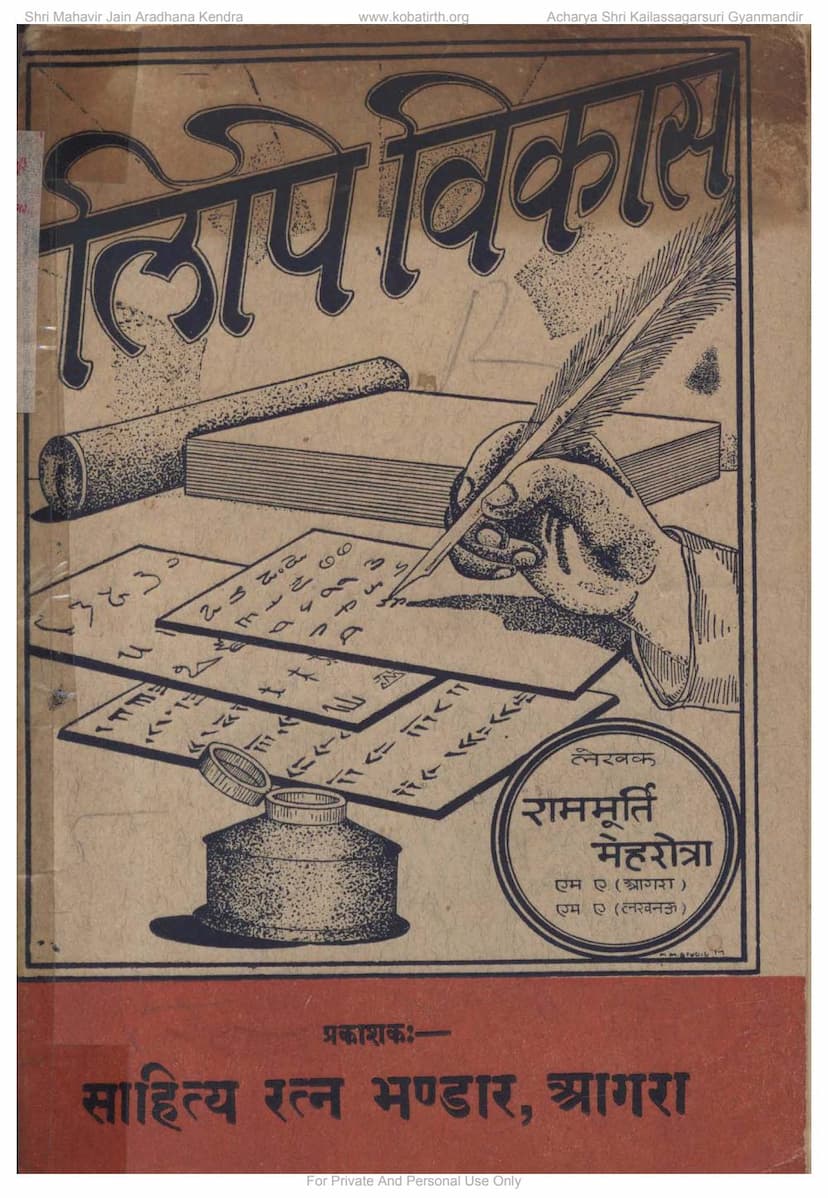Lipi Vikas
Added to library: September 2, 2025

Summary
Here's a comprehensive summary of the Jain text "Lipi Vikas" by Rammurti Mehrotra, based on the provided pages:
Book Title: Lipi Vikas (लिपि विकास) Author: Rammurti Mehrotra Publisher: Sahitya Ratna Bhandar, Agra
This book, "Lipi Vikas," by Rammurti Mehrotra, published by Sahitya Ratna Bhandar, Agra, delves into the evolution and development of scripts (lipis). The provided pages offer a detailed historical and analytical exploration of how writing systems originated and transformed over time, with a particular focus on Indian scripts and the Devanagari script.
Key Themes and Content:
-
The Necessity of Script: The book begins by establishing the fundamental human need for communication beyond immediate speech. It highlights how written language provides permanence, allows for communication across distance and time, and is crucial for preserving knowledge, literature, and history for future generations.
-
Early Forms of Script: Mehrotra traces the origins of writing beyond just alphabetic scripts. He discusses:
- Rope/Knot Script (रज्जु/ग्रन्थि-लिपि): This early form of communication involved using knots on ropes to record information, as seen in cultures like the Inca (Quipu) and ancient China. The author suggests that the color of the threads and the types of knots conveyed different meanings.
- Line Script (रेखा-लिपि): This refers to the use of lines, strokes, and simple geometric shapes for recording information. The author posits that number systems may have originated from this.
- Ideographic/Pictographic Script (भाव-प्रकाशक लिपि / चित्र लिपि): This involves using pictures and symbols to represent objects, ideas, and events. The book details how these symbols evolved from depicting entire events to representing individual objects (logographs) and eventually, sounds. Examples include ancient Egyptian hieroglyphics and early Chinese script.
-
Transition to Phonetic and Alphabetic Scripts: The book explains the progression from ideographic scripts to phonetic scripts, where symbols began to represent sounds.
- Sound-Indicating Picture Script (ध्वनि प्रकाशक चित्र लिपि): This stage saw picture symbols being adapted to represent sounds.
- Syllabic Script (अक्षर लिपि): Here, symbols began to represent syllables, simplifying writing. The evolution of Japanese script from Chinese is given as an example.
- Alphabetic Script (वर्ण-मूलक लिपि / आद्यध्वनि (व्यंजन) मूलक लिपि): This is the stage where individual sounds (vowels and consonants) are represented by distinct symbols. The author discusses how these symbols often originated from pictograms that represented objects beginning with that sound (e.g., Brahmic 'Dha' resembling a bow). The development of Semitic scripts, Phoenician, and eventually Roman script is touched upon.
-
The Significance of Brahmī Script: A major focus of the book is the Brahmī script, considered the progenitor of many Indian scripts.
- Origin Debates: Mehrotra discusses and critically examines the theories of Western scholars like Weber and Bühler who proposed that Brahmī originated from Phoenician or Aramaic scripts.
- Indian Origin: The author strongly argues for the indigenous origin of Brahmī, citing scholars like Cunningham, Fleet, and Ojha. He highlights the completeness and scientific nature of Brahmī, its distinct features (like vowel-consonant interaction through matras), and the lack of direct evidence for foreign influence. The inscription on Hyderabad pottery is presented as evidence of Brahmī's antiquity predating the proposed Semitic influence.
- Brahmi's Influence: The book details how Brahmī evolved into various northern and southern Indian scripts, including Gupta, Kutila, and eventually modern scripts like Nagari.
-
Development of Nagari (Devanagari): The book traces the evolution of the Nagari script from Brahmī through intermediate stages like Gupta and Kutila. It discusses the various theories for the name "Nagari" and its spread.
-
Development of Kharosthi Script: The book also analyzes the Kharosthi script, noting its right-to-left direction, its origins likely from Aramaic, and its prevalence in northwestern India. It contrasts Kharosthi with Brahmī, highlighting its incompleteness and lack of influence on later Indian scripts.
-
Evolution of Numerals: A significant portion of the book is dedicated to the development of numerals.
- Early Systems: It mentions the lack of a zero symbol in early numeral systems and the use of distinct symbols for multiples of ten.
- Indian Numeral System: The book emphasizes the revolutionary contribution of the Indian decimal system, the concept of place value, and the invention of zero. It credits the Aryans/Brahmins for this development.
- Spread of Indian Numerals: The author details how Indian numerals were transmitted to the Arab world and subsequently to Europe, forming the basis of our modern numeral system.
- Evolution of Individual Digits: The book provides a detailed historical account of the evolution of individual digits from ancient forms to modern ones.
-
Comparative Analysis of Scripts (Hindi vs. Others): A substantial part of the book compares the Hindi script with other major scripts like Urdu, Roman (English), Bengali, Gurmukhi, and Gujarati. The comparison is based on criteria such as:
- Phonetic Accuracy (Nishchay): How accurately a script represents sounds, with Hindi being praised for its one-to-one sound-symbol correspondence, unlike Urdu and Roman.
- Utility (Upayogita): The script's ability to represent all necessary sounds without redundancy or deficiency. Hindi is presented as superior due to its comprehensive phonetic representation.
- Simplicity (Saralta): Ease of learning and writing. Hindi is deemed simpler than Urdu (due to joined letters/shoshas) and Roman.
- Aesthetics (Saundarya): Visual appeal, with Hindi's headstrokes (sirbandi) contributing to its beauty compared to Urdu and Roman.
- Speed of Writing (Tvara Lekhan): Efficiency in writing. While Roman and Urdu may involve less lifting of the pen, Hindi's clarity and completeness are prioritized.
-
Suggestions for Improvement: The author concludes by suggesting potential improvements to the Hindi script to make it even more scientific and efficient, such as refining certain letterforms and standardizing vowel markings.
In essence, "Lipi Vikas" by Rammurti Mehrotra is a scholarly and comprehensive work that traces the historical trajectory of writing systems, championing the indigenous origins and scientific superiority of Indian scripts, particularly Brahmī and its descendant, Devanagari (Hindi), while also highlighting the remarkable Indian contribution to the global numeral system.